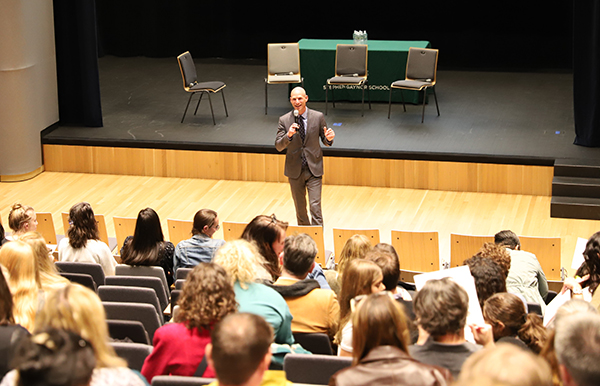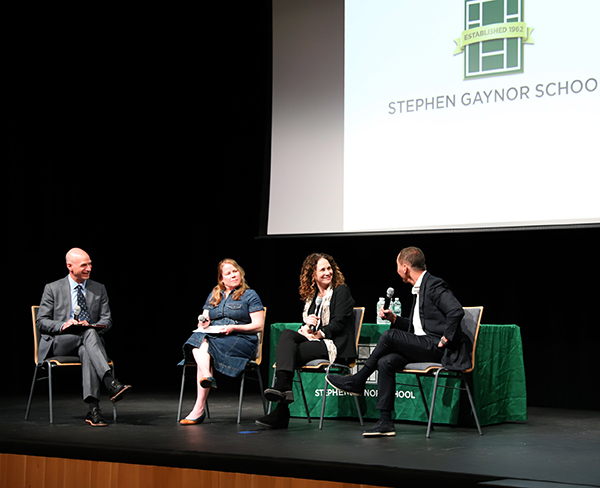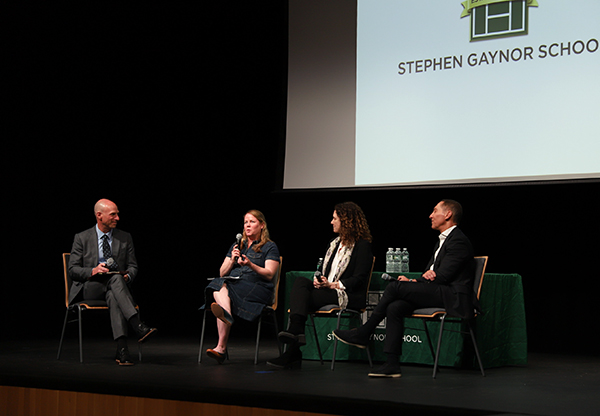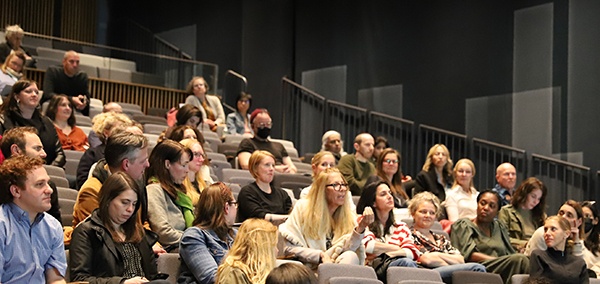Sometimes, what makes us different and challenges us also brings us together. On Tuesday, April 11, over 200 members of the Gaynor community (parents of current, past, and future students, alumni, students, faculty and staff, and friends) joined together in the Yvette Siegel-Herzog Performing Arts Center for a special screening of the documentary on ADHD, The Disruptors. The screening was followed by a panel discussion led by Head of School Dr. Scott Gaynor, and featured Dr. Roy Boorady, Senior Child and Adolescent Psychiatrist at the Child Mind Institute; Dr. Amy Margolis, Associate Professor of Medical Psychology and Director of the Environment, Brain, and Behavior Lab at Columbia University Irving Medical Center; and Jill Thompson, Assistant Head of School at Stephen Gaynor School. The film and the panel discussion had the audience nodding their heads in recognition as the stories and experiences resonated with those in the room.


Attention Deficit Hyperactivity Disorder (ADHD) is one of the most commonly diagnosed — and widely misunderstood — neurological conditions in the world today, affecting nearly ten percent of children in the U.S. and a rising number of adults. The Disruptors documentary features interviews with prominent figures who have been diagnosed with ADHD and who describe both the challenges and advantages of ADHD. It also follows several families through their daily lives as they navigate the difficulties, and the surprising triumphs, of living with ADHD. The film helps debunk the most harmful myths surrounding ADHD, and examines the flip side of this trait – ultimately offering a revelatory understanding of the diagnosis, and real hope for millions of kids, families, and adults with ADHD.
After the film screening, Dr. Gaynor kicked off the panel discussion by posing his first question: “Everyone in the room tonight has some understanding of ADHD or might know someone with it, or maybe even their own child might have it. For me, I feel this movie has helped me learn even more about the diagnosis. Why is this movie important to you?”
Assistant Head of School Jill Thompson responded, “Because I work with children with ADHD. Here at Gaynor, part of our mission is that, unless you understand these children, you cannot create an individualized lesson plan or instructional plan for them. So it’s really important to truly understand what are some of the symptoms of ADHD, and what are some of the strategies and techniques that support students with ADHD. So that’s why this movie is important, and I hope everyone at our school gets an opportunity to view the movie and really get a deeper understanding of how our students’ brains work and how they learn.”
Dr. Amy Margolis, who appears in the documentary, said, “It was an exciting process to be part of the film. I think it’s incredibly important to hear shared experiences, and for me, that was how they got me interested. When [the filmmakers] told me that they were going to follow families and really take a deep dive and look at kids from different social strata and kids with different challenges, I really was engaged and excited that maybe we could make something that would help people who struggle to parent their kids to have a shared experience, or for the kids themselves to see the film and see that they’re not alone.”
“As somebody who loves movies, I’m so glad they actually made a documentary [about ADHD],” said Dr. Roy Boorady. He continued by saying that most of the movies that have characters with ADHD are fictionalized, like the Percy Jackson series. “But to have a documentary, people can see themselves in the movie in a way that’s much more relaxed. I think it is educational for the parents themselves, but it is also a way to connect with your child by watching a film or movie and then talking about it with them afterward.”
The panelists discussed the issues surrounding medication for ADHD, and how medication is one component of a larger comprehensive approach to treating ADHD. The panelists all agreed that medication can have positive impacts, but that it should be paired with other components to support children and adults with ADHD.
Dr. Gaynor closed out the formal discussion by asking, “If you can think of one thing, because we’re all parents, educators and we want to best support our children and our students in the best way possible, what do you think we can do to best invest in the future for our children?”
Dr. Boorady said, “Staying positive. I think the amount of head nodding [I saw this evening] meant that the audience related to the message of supporting kids’ self esteem and being positive. I think another thing is putting together the right team to help the family help the child to manage this.”
Dr. Margolis agreed, saying, “I love that you said to do that. I think kids knowing that people believe in them is so incredibly important, and when you grow up with a learning disability or ADHD, you get these subtle messages from the world from long before you go to school that you’re doing something wrong, and parents don’t mean to send that message, but the kids are getting that message. I think if we can give them all other kinds of messages that what they’re doing is great or they’re great, that is so helpful.”
Ms. Thompson added, “I think the combination of a strengths-based approach, and creating an executive function-rich environment is so important. In the movie, one family posted questions around the house instead of telling their child what to do all the time. So the child has to think about what they are doing, and that really gets them to think about what they need to do instead of always having to harp on them. Creating an environment that gives them the time to think and to develop those skills is really important.” For more about executive function instruction at Gaynor, visit this article co-authored by Dr. Margolis titled, “Executive Functions Are Embedded in the Curriculum at Stephen Gaynor School.”
One audience member asked about brain function in those with ADHD and the fact that kids with ADHD seem to have developmental delays in certain areas. Dr. Margolis said, “I think a really kind of fun way to understand ADHD in the brain in terms of brain function is that we have a part of our brain that turns on when we have to do something. We think of those as ‘task positive circuits,’ so if I asked you to say the alphabet backwards your task positive circuit would be working. On the other hand, we have a part of the brain that is active when we’re spacing out. And those two parts of the brain work in opposition to each other, right? So if you’re spacing out, you can’t be doing a task-positive thing. And that balance seems to be off in people with ADHD. What we know about age-related change in the brain and ADHD is that these kids are going to get there, they just get there a little slower. And I think as parents or teachers, our job is to just make this space for them to be able to get there without feeling bad about themselves.”
This event was more than just a screening and a panel discussion; it was an opportunity for the members of the audience to feel seen, to recognize their experiences in those of others, and to better understand the challenges and strengths of the ADHD brain.
Dr. Boorady sent a thank you to the Gaynor community. Read it here.


